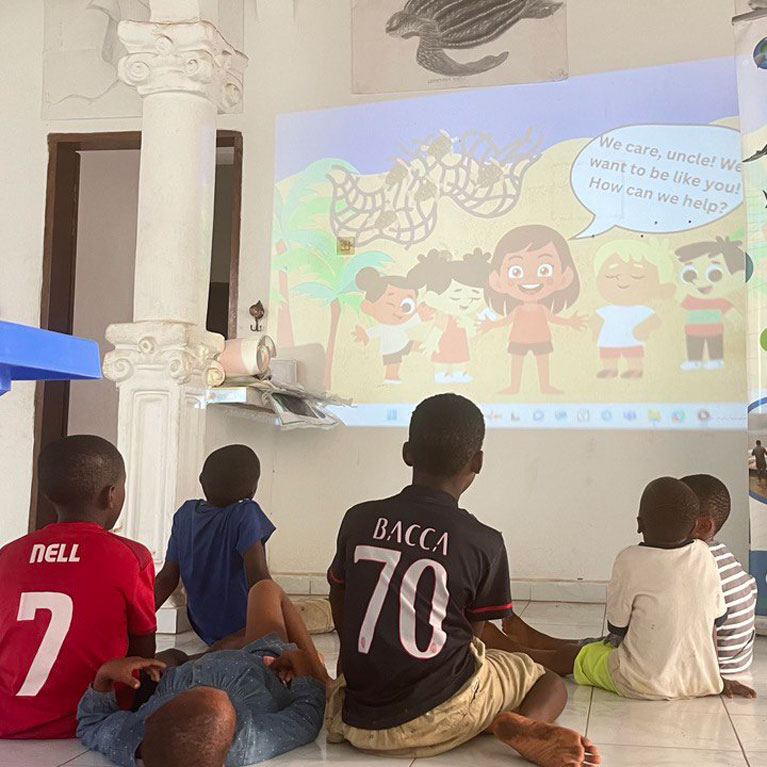Sharks come to life in cartoons in Cameroon
Inspiration and entertainment underscore Cyndi’s fresh take on conservation education for children in Cameroon. The coastal country hosts 28 ray species and 17 shark species, and while there is often cultural significance associated with these species, there is no legal protection and in general there is little awareness of their conservation status. Cyndi is creating and distributing culturally relevant cartoon animations to inspire young Cameroonians to act to save sharks and rays.
I am a certified diver and marine scientist with a Master’s degree in the management of aquatic ecosystems. My academic journey – five years of studying marine wildlife and conservation at university – has equipped me with extensive skills and knowledge in this field. For the past three years I have served as the head of the Environmental Education Programme at the African Marine Mammal Conservation Organisation (AMMCO). Having started as an intern, I’ve been instrumental in designing and implementing educational programmes in various coastal sites in Cameroon, including Limbe, Kribi, Dizangue and Nkam. My role also includes...
Animated cartoon for environmental education: a strategy to inspire action among youth in Limbe, Cameroon
The project’s key objective is to raise awareness and inspire conservation action among children and local communities in Limbe, on Cameroon’s northern coast, through engaging and culturally relevant animated cartoons that focus on the protection of sharks and rays, particularly Critically Endangered species.
This project addresses a significant challenge in the conservation of sharks and rays along the northern coast of Cameroon, where cultural beliefs and a lack of awareness have led to unsustainable fishing practices. Often misunderstood, sharks and rays are seen as dangerous or overly abundant by many people, which leads to their decline. By creating culturally relevant educational cartoons, the project aims to engage communities and inspire conservation efforts to protect these species and preserve marine ecosystems.
Elasmobranchs, which include shark and ray species, have become a central focus of international conservation efforts due to their ecological importance and the increasing threats they face. The northern coast of Cameroon is home to 28 ray species and 17 shark species, some of which are endemic or Critically Endangered. Despite their cultural significance for local communities, there is no legal protection for these species and little awareness of their ecological role. Overfishing and bycatch pose significant threats, and rays, known locally as ‘coverpots’, are often consumed without regard for their conservation status.
AMMCO has conducted environmental education programmes in 30 schools around Limbe. These have yielded some positive results, but there is still much room for improvement. Many children in these communities find it difficult to understand traditional teaching methods, which contributes to their lack of awareness. A recent survey by AMMCO revealed that 80% of students lacked sufficient knowledge about the ecological importance of elasmobranchs and the human activities that threaten their survival.
To address this, the project aims to develop culturally relevant educational cartoons that utilise storytelling to both entertain and educate. By 2025, the project hopes to have increased awareness of shark and ray conservation among at least 40% of the students, which will foster a deeper understanding of the need to protect these vulnerable species.
- To educate children and communities on the northern coast of Cameroon about the importance of sharks and rays.
- To engage local communities in conservation efforts, by contributing as heroes or artists.
- To create and distribute culturally relevant cartoon animations that emphasise conservation messages, in order to inspire the younger generation to take action.
- To increase awareness of the threats facing sharks and rays, such as overfishing and bycatch, and of sustainable fishing practices.
- To encourage community-driven conservation action, such as joining AMMCO’s Siren citizen science network or releasing accidentally caught sharks and rays.


